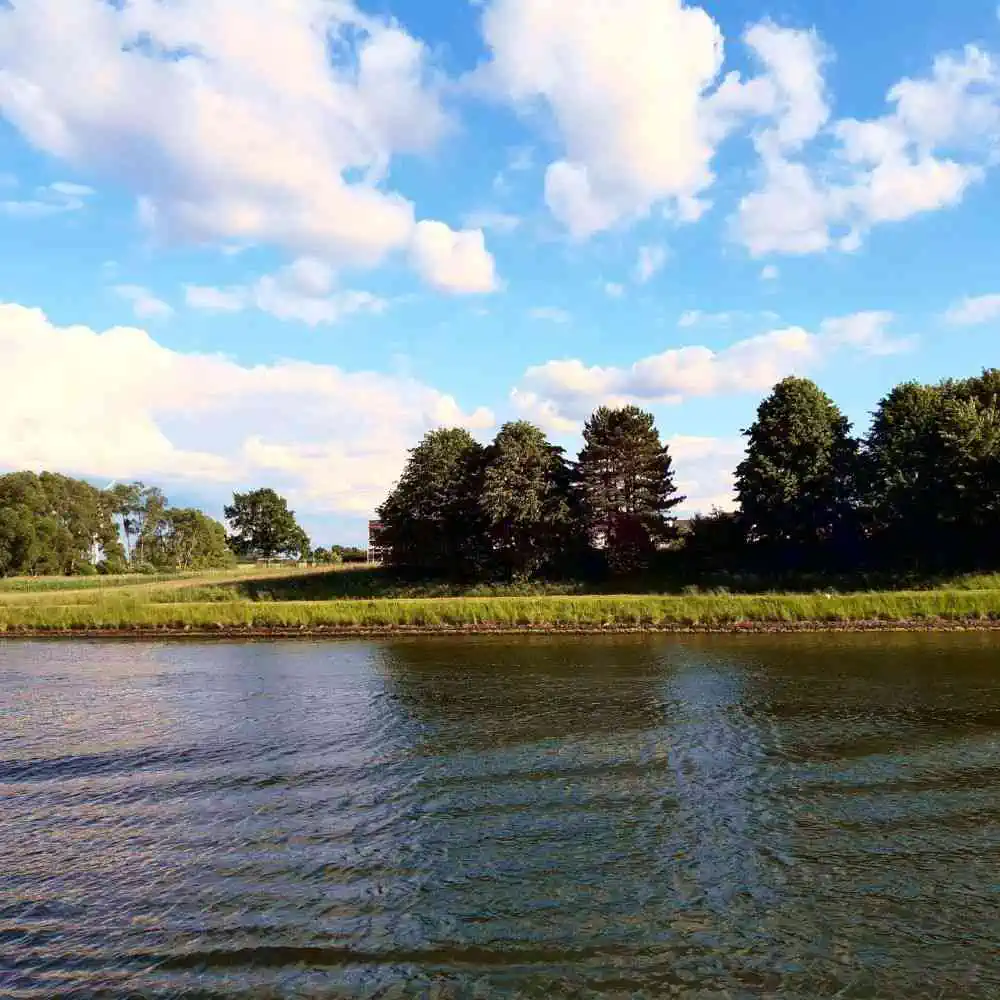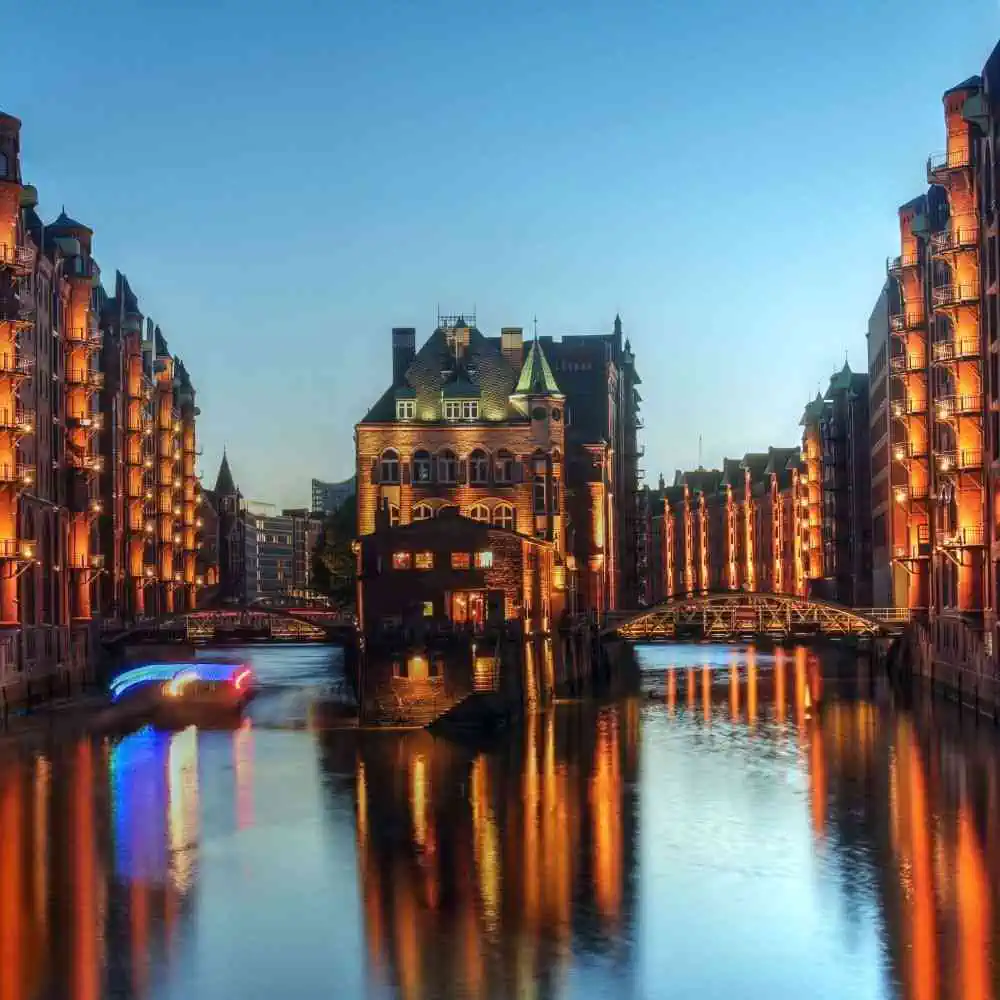You will depart from Kiel Hbf, located right in the city center of Kiel, and enjoy the beautiful scenery of the journey while you arrive in Hamburg Hbf, also located in the heart of Hamburg.
Trains from Kiel to Hamburgfrom € 15.00
Trains from Kiel to Hamburg
Travelling by train: Kiel - Hamburg
Main Stations:
The two main stations along this route are Kiel Hbf and Hamburg Hbf. Kiel Hbf lies within the city centre of Kiel and features a unique and modern design. It also has a full range of facilities, including a station restaurant and shop. Hamburg Hbf, on the other hand, is the largest station in the city and is located near the city centre. It is a fascinating station, featuring a unique steel-clad roof, cafes, restaurants, shops and a modern-styled waiting area.Important Cities & Towns:
Along the journey from Kiel to Hamburg, you will pass through several charming towns and cities. These include Elmshorn, Ahrensburg, Borsigwalde, Norderstedt, Neugraben Süd, Stillhorn West, Fischbek Süd, and Volksdorf. Each of these cities and towns offers something special and unique, and you can enjoy the captivating views as you pass through them.Iconic Item:
The journey from Kiel to Hamburg is memorable for its stunning views and the unique sights that you come across along the way. While travelling on the train, you can spot many iconic German landmarks, such as the Church of St. Nicholas in Ahrensburg, the Windmill in Elmshorn, and the historic structures in Borsigwalde.Travelling by train from Kiel to Hamburg is an incredible experience, as you can admire the spectacular views and many charming towns and cities that you pass through. The entire journey is estimated at 1 hour and 28 minutes, so it is an efficient and pleasant way to travel between the two cities.

Journey details
How long does the train from Kiel to Hamburg take?
The train from Kiel to Hamburg takes around 2 hours and 15 minutes.
What is the fastest journey from Kiel to Hamburg by train?
The fastest journey from Kiel to Hamburg by train is 2 hours and 3 minutes.
How much does the train cost from Kiel to Hamburg?
The cost of the train from Kiel to Hamburg is around €17.60 for a one way ticket and €26.00 for a return ticket.
How much does the Kiel to Hamburg?
Yes, there is a direct train from Kiel to Hamburg.
What is the distance from Kiel to Hamburg by train?
The distance from Kiel to Hamburg by train is 118 kilometres.
Which are the cities that the train stops from Kiel to Hamburg?
The train stops in Neumünster, Norderstedt, and Ohlsdorf on the route from Kiel to Hamburg.
Kiel: Places to see
Kiel is a vibrant and beautiful port city in the German state of Schleswig-Holstein. With a rich history of seafaring and trade, Kiel is a destination for those seeking a combination of picturesque waterfronts and cultural immersion. Whether you’re looking for grand architecture or cool nightlife, there’s something for everyone here. From ancient historical sites to contemporary cafes, here are the top things to do, see and try in Kiel.
Kiel Fjord: Kiel Fjord is a stunning body of water that can be explored by boat or kayak. Here travelers can take in the views of the surrounding mountains and Kiel’s maritime charm. The fjord is also home to an array of wildlife, including seals and seabirds.
St. Nicholas' Church: St. Nicholas' Church is a Gothic-style cathedral and one of Kiel’s most important historical and architectural sites. The building, dating back to the 13th century, boasts a distinctive onion dome and is renowned for its beauty and grandeur.
Old Market Square: Old Market Square is at the heart of the city and is a major attraction in Kiel. Surrounded by centuries-old buildings, the market square hosts an array of markets, events, and festivals, and is also an excellent spot to sample some local food and drink.
Kiel Canal: Kiel Canal is an impressive feat of engineering and connects the Baltic Sea with the North Sea. It is the busiest artificial waterway in the world and can be explored on a boat tour or from a nearby bridge.
Kiel Town Hall: Kiel Town Hall is a stunning Renaissance building in the heart of the city. Its façade is adorned with statues, while its interior is decorated with lavish stucco work and frescoes. It is open to the public and offers guided tours.
Kiel Aquarium and Zoo: Kiel Aquarium and Zoo is a great place for travelers with kids. It is home to a huge array of species and features a diverse array of walk-through exhibits.
Forum Kiel: Forum Kiel is a contemporary entertainment venue and cultural hub with an array of live music, theater, and film screenings. Its many restaurants and bars are popular with locals and visitors alike.
From stunning architecture to fascinating historical sites, Kiel has something for everyone. Its combination of vibrant nightlife and picturesque waterfronts make it the perfect place to explore and unwind. And, be sure to feast on Kiel’s regional specialties, such as its delicious fish and smoked salmon.

Hamburg: Places to see
As one of Germany’s most inviting cities, Hamburg offers a unique combination of culture, history, and modernity. From magnificent churches, to medieval streets, to bustling city squares, there’s plenty to explore in this city. Whether you’re looking for an adventure or a relaxing getaway, Hamburg is sure to offer an unforgettable experience for all types of travelers.
St. Nikolai Memorial: The St. Nikolai Memorial is the tallest building in all of Hamburg and is the main attraction of the historical Speicherstadt district. Located in the heart of the city, the memorial was originally built as a church in 1874, but was damaged in the Second World War. Now a memorial, visitors are able to ascend the tower and enjoy panoramic views of the city. Admission is free and the memorial is open daily from 10:00 am to 6:00 pm.
Town Hall: Located in the city center, the Town Hall is the seat of the city’s government and a symbol of Hamburg’s autonomy throughout its long history. Constructed in the Gothic Revival style, the building is home to the Senate and Parliament, and its landmark clock tower can be seen from throughout the city. Entrance to the building is free and visitors can enjoy daily tours from 10:00 am to 6:00 pm.
Hamburg Rathausmarkt: This public square serves as the focal point of the city. Lined with restaurants and artisan boutiques, the market is the perfect place to experience the hustle and bustle of the city. At the center of the square is a historic fountain, surrounded by a colorful array of seasonal plants and flowers. The Rathausmarkt is open daily, and visitors should be sure to sample some local delicacies like Labskaus, Hamburg’s signature potato dish.
Altona Fish Market: Located on the banks of the Elbe River, the Altona Fish Market is a lively weekend tradition. Since 1703, the market has been attracting locals and visitors alike. Visitors can enjoy fresh seafood, stroll along the stalls, and take part in one of the traditional auctions. The market is open early on Sundays, and visitors should be sure to get there early to beat the crowds.
St. Michael’s Church: One of the city’s most iconic landmarks is the St. Michael’s Church. Construction of the church began in the early 19th century and it now stands as an impressive example of Gothic-revival architecture. While the exterior is stunning, the church also houses a beautiful interior, complete with stained glass windows, a pipe organ, and intricate paintings. Entrance is free and visitors can enjoy free guided tours on weekends.
Hamburg Dungeon: An interactive museum, the Hamburg Dungeon is a great way to learn about the city’s dark past. Through an immersive experience, visitors are taken on a journey through Hamburg’s history, and recounted the tales of darkness, torture, and destruction that defined the city’s past. The dungeon is open throughout the year, and tickets are available online.
International Maritime Museum: Located in the historic Speicherstadt district, the International Maritime Museum is the largest of its kind in the world. This museum is dedicated to Hamburg’s seafaring history, with an impressive collection of artifacts, models, and interactive exhibits. The museum is open daily, and visitors should be sure to check out the iconic model of the Flying P-Liner Potomac, the largest model ship in the world.
From awe-inspiring churches to lively markets, Hamburg offers a wealth of fascinating attractions and activities. With its vibrant culture, captivating history, and delicious cuisine, it’s no wonder the city has been capturing the hearts of travelers for centuries.

Kiel: Main train stations
Kiel, in Germany, is home to the main railway station for the area, Kiel Hauptbahnhof. The station is the hub of the city’s railway network and offers connections to towns both near and far. There are also several other significant train stations within Kiel, including Kiel-Wik, Kiel-Schreventeich, and Kiel-Mettenhof.
Kiel Hauptbahnhof is located at Hermann-Föge-Straße 1, 24103 Kiel, Germany. It is open 24 hours a day, allowing travelers to come and go as they need. The station has a customer service center which can be contacted over the phone on +49 (0)431 9568 50 or by email at kundencenter@kb-kiel.de. It also offers luggage storage for short-term visitors.
- Kiel Hbf
Hamburg: Main train stations
The main train station of Hamburg is Hamburg Hauptbahnhof, located in the northern part of the city, in Germany. It is one of the largest in Europe, and it is a major hub for the InterCity Express and long-distance trains. Other important train stations in the city are Hamburg-Altona and Hamburg-Dammtor, serving regional and suburban trains.
Hamburg Hauptbahnhof is located at Am Bahnhof 1, Hamburg, 20355 Germany. The station is open 24/7. The platforms open 30 minutes before the departure of the trains. For more information, call the number +49 (0)40 31110. There are luggage storage services at the station, located in the service centers.
- Hamburg HBF
- Hamburg-Altona
- Hamburg Alte Wohr
- Hamburg Dammtor
- Hamburg-Harburg
- Hamburg-Bergedorf
- Hamburg-Blankenese
- Hamburg Klein Flottbek
- Hamburg-Poppenbuttel
- Hamburg-Ohlsdorf
- Hamburg-Sternschanze
- Hamburg-Neugraben
Kiel - Hamburg: How to get the best deals
Book in Advance:
Just like with airfares, train ticket prices tend to rise as the departure date gets closer. Booking weeks or even months in advance can save you a significant amount.
Travel During Off-Peak Hours:
Avoid traveling during peak times such as weekday mornings and evenings. Opt for midday, late evening, or mid-week rides when there's less demand.
Consider Slower Trains or non direct routes:
Express or high-speed trains might save time, but they're often pricier. Opting for regional or slower services can reduce your fare.
Look for Special Deals and Promotions:
Train operators occasionally have promotions or special deals, especially during off-peak seasons. It's worth signing up for newsletters. Additionally, there are sometimes group or return ticket discounts, so consider these options if they fit your travel plans.
All you need to know about
Need our help?
- Contact Us
Guaranteed secure payment
Certificates


